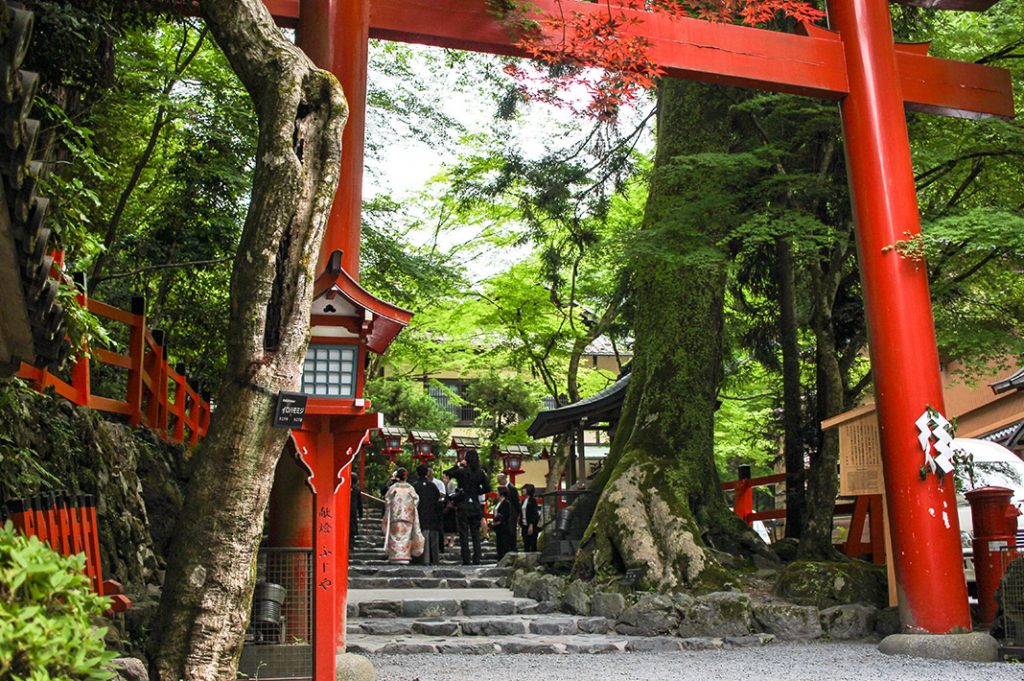In a stroke of genius, I decided to make the journey into the mountains north of Kyoto, where the rushing river and shaded streets would offer respite from the summer heat. Even though it was the rainy season, it had been dry and sunny day after day. Arriving in the town of Kibune, I wandered along the main road until I found myself at the venerable (and very Instagrammable) Kifune Shrine.

Top Photo Spot
The massive red torii gate was a striking contrast to the lush green surrounds, and an ancient, moss covered maple tree stood just inside. Ahead, the famous stone steps, lined with red lanterns, ascend to the shrine. A wedding photoshoot was taking place in front of this scene, confirming its popularity.
After the photographer waved us through, I began my climb. The path was carved out of the mossy hillside which also had trees to offer shade.
The rows of vermillion lanterns formed a picturesque scene—reputably beautiful when blanketed in winter snow. I breathed in the soothing forest smells and continued onward.
The Kifune Shrine grounds
At the top of the staircase, I found myself in a gravelled opening. Up here, you can hear the rushing Kibune River below, interrupted only by the occasional birdcall.
To my right, a wooden structure for quiet contemplation that smells of the fragrant timber used to construct it. Sitting in there, watching the wall of swaying branches, is extremely soothing.
Across the opening is a statue of two rearing horses in-front of the elevated Main Hall. Beside the horse statue stands the chozuya, the place to ceremoniously purify yourself before entering any further. These are a common feature of both temples and shrines.
Customarily, you fill the bamboo ladle and wash your left hand, right hand, mouth and finally the handle.
The staircase beside the chozuya takes you up to the entrance of the main hall, as well as a shop selling lucky charms and omikuji (paper fortunes).
The main hall is beautifully and intricately designed and houses a number of rituals throughout the year.
Fortunes and wishes
Kifune shrine is dedicated to a kami (god) associated with water—Takaokami-no-kami, the god of rain. As such, the omikuji here are rather unique; they’re printed on a special type of paper which reveals the fortune when dipped into the water basin.
There is even a QR code on each one so you can get a translation of your fortune in your language. After you’ve come to terms with your fate, tie your paper up along with the others.
The ema (small wooden plaques for wishes) here carry significant meaning, too. The maple leaf shaped ema pays homage to the many surrounding trees, while the ones with horses refer to an ancient tradition. As the shrine is dedicated to the god of rain, officials would offer live horses as gifts to the gods, in the hopes of sending or stopping rain. A black horse was sent when rain was needed, while a white horse meant they wanted the rain to stop. This was an elaborate offering which necessitated a high level of care and cost. Therefore, these days, it’s much easier to write your wish on a small piece of wood shaped like a horse.
Legend has it…
Once upon a time, a goddess from Osaka sailed along the river, all the way to this location in the mountains. Kifune Shrine marks the end point of her journey. However, the original site (okunomiya honden) is located about a kilometer along the road. There, you can see a large rock where she is said to have tied her boat, as well as renri-no-sugi—a cedar and maple tree fused together. Okunomiya was damaged by natural disaster almost 1,000 years ago which is why the shrine was moved to the current location.
It’s possible to walk between these two sites, passing the third part of the shrine about mid-way. The third part, Yui-no-yashiro, is the place to wish for finding a successful partner (romantic or business). Write your wish on the green paper and tie it with the others.
I had considered writing a prayer for rain back at the Main Hall, but after checking my weather app, I could see it wouldn’t be necessary; rain was coming after all.
Getting to Kifune Shrine
From Kyoto Station, take the JR Nara Line to Tofukuji Station. Transfer to the Keihan Main Line to Demachi-Yanagi Station. Next, take the Eizan Kurama Line through to Kibune-guchi Station (30mins). From here, you can walk for around 25 minutes into town or catch the bus 5 minutes. There is one bus to meet each train arrival so you don’t have to worry about missing it. Allow around an hour to get there from Kyoto.
Kifune Shrine
Location: Kibune. 180 Kuramakibunecho, Sakyo Ward, Kyoto, 601-1112
Open: 9am–5pm, 7 days
Admission: Free
URL: http://kifunejinja.jp/ (in Japanese)
Post by Japan Journeys.